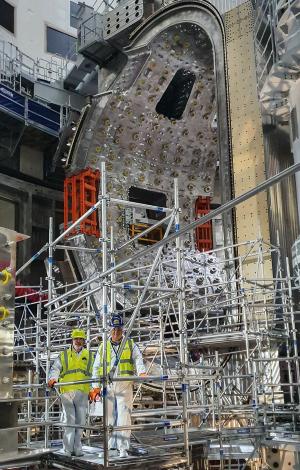Plasma physicists never retire
Five years ago, in late 2017, David Campbell retired from the ITER Organization. A veteran plasma physicist who had spent 14 years at JET and participated in the JT-60U research program, he was appointed in 2006 as the ITER Organization was building up its management team. Over the years, under different job titles, David was to lead the project's science activities—a responsibility that culminated in the publication of the ITER Research Plan, a baseline document which forms the basis for research and operations planning for the coming years.
Plasma physicists, however, are not meant to retire completely. The knowledge and expertise they have accumulated remains in high demand and, in David's case, this meant chairing the Advisory Board of the Max Planck Institute for Plasma Physics in Garching, Germany; participating in the Advisory Board for the Princeton Plasma Physics Laboratory; writing and editing the fusion chapters of the Encyclopedia of Nuclear Energy; and working with his former team at ITER on a journal article summarizing the 400-page ITER Research Plan. "It's more work than expected but I guess this has been the story of my life..." smiles David, who visited ITER recently with his wife Judith, a former ITER documentation specialist.
In the five years since David left, many things have changed in the fusion world, one of the most striking being the sudden emergence of private investment in fusion and the plethora of startups being established throughout the world. "With a few exceptions, it is difficult to follow what is happening there. For reasons that are easy to understand, the startups do not publish much detail on the technology they are implementing or plan to develop, which makes it difficult to judge the merits of the time scales they advertise."
After decades of relative indifference, fusion seems to be on every newspaper front page and magazine cover. However, the former head of ITER science harbours a sober vision of the future. "Fusion alone will not solve the climate problem. But it can be a significant long-term energy source. And it's one of the very few major energy resources that humanity will have available in the future ..."
ITER has also changed dramatically over the past five years. "When I left, none of the big components had yet arrived. Now the vision in the Assembly Hall is simply extraordinary. You expect to be overwhelmed and indeed you are, way beyond your expectations. It's marvellous to see it happening after all these years." But beyond the technological achievements and the "elegant engineering," what deeply moved David was the sheer beauty of what he saw—"the different shapes, colours and shades" that lend to ITER its unexpected artistic dimension.


